Flow Orientation Analysis for Major Activity Regions Based on Smart Card Transit Data
Abstract
:1. Introduction
- To understand major activity regions in a city, morning and evening HIRs were derived and investigated from real transit data.
- To provide a comprehensible way of showing public movement, the method for flow orientation analysis were developed with a directional inflow vector and a dominant factor.
- To lessen the complexity of complicated transportation networks, the Geohash system was adopted for scalable abstraction of bus stops and subway stations.
- To show similar flow orientation patterns of HIRs, hierarchical clustering of HIRs was applied and then visualized on a city map.
- Through a smart card transit data in Seoul, the illustration and effectiveness of the proposed method for flow orientation analysis were presented.
2. Related Work
3. Methodology
3.1. Data Pre-Processing
3.2. Discovery of High Inflow Regions
3.3. Flow Orientation Analysis
4. Experiments
4.1. Data Pre-Processing
4.2. Discovery of HIRs
4.3. Flow Orientation Analysis
5. Conclusions and Future Work
Acknowledgments
Author Contributions
Conflicts of Interest
Appendix A
| HIR | Geohash | df | fmax | HIR | Geohash | df | fmax | HIR | Geohash | df | fmax | HIR | Geohash | df | fmax |
|---|---|---|---|---|---|---|---|---|---|---|---|---|---|---|---|
| HIR1 | wydm6d | 0.63 | 8005 | HIR51 | wydm6e | 0.69 | 2187 | HIR101 | wydmfx | 0.63 | 897 | HIR151 | wydjxg | 0.71 | 777 |
| HIR2 | wydm9w | 0.49 | 5460 | HIR52 | wydm61 | 0.69 | 2128 | HIR102 | wydjr7 | 0.53 | 717 | HIR152 | wydms8 | 0.38 | 367 |
| HIR3 | wydm9m | 0.53 | 5782 | HIR53 | wydm1w | 0.71 | 2244 | HIR103 | wydm2j | 0.73 | 1205 | HIR153 | wydq5b | 0.52 | 471 |
| HIR4 | wydm75 | 0.56 | 5983 | HIR54 | wydm3p | 0.52 | 1370 | HIR104 | wydjqz | 0.51 | 683 | HIR154 | wydm93 | 0.33 | 339 |
| HIR5 | wydm9x | 0.50 | 5136 | HIR55 | wydjx9 | 0.46 | 1149 | HIR105 | wydq59 | 0.66 | 964 | HIR155 | wydmgu | 0.59 | 545 |
| HIR6 | wydm6f | 0.55 | 5667 | HIR56 | wydmfb | 0.32 | 862 | HIR106 | wydm69 | 0.68 | 1014 | HIR156 | wydmbd | 0.34 | 337 |
| HIR7 | wydm7k | 0.58 | 5546 | HIR57 | wydjrt | 0.44 | 1049 | HIR107 | wydmfv | 0.45 | 598 | HIR157 | wydjw6 | 0.59 | 532 |
| HIR8 | wydm9k | 0.39 | 3310 | HIR58 | wydmee | 0.62 | 1545 | HIR108 | wydjry | 0.65 | 934 | HIR158 | wydmes | 0.76 | 911 |
| HIR9 | wydm2n | 0.56 | 4344 | HIR59 | wydmdr | 0.47 | 1102 | HIR109 | wydm7u | 0.51 | 655 | HIR159 | wydjxw | 0.53 | 462 |
| HIR10 | wydm9y | 0.66 | 5326 | HIR60 | wydjrx | 0.36 | 903 | HIR110 | wydm1n | 0.46 | 779 | HIR160 | wydmgr | 0.49 | 417 |
| HIR11 | wydm8s | 0.55 | 3928 | HIR61 | wydmf8 | 0.54 | 1246 | HIR111 | wydm91 | 0.51 | 657 | HIR161 | wydjwt | 0.63 | 583 |
| HIR12 | wydm9r | 0.59 | 4202 | HIR62 | wydmed | 0.49 | 1109 | HIR112 | wydm1m | 0.48 | 821 | HIR162 | wydmmp | 0.47 | 515 |
| HIR13 | wydm9z | 0.52 | 3350 | HIR63 | wydq4e | 0.61 | 1445 | HIR113 | wydm24 | 0.63 | 837 | HIR163 | wydm22 | 0.61 | 522 |
| HIR14 | wydm9v | 0.46 | 2875 | HIR64 | wydmsc | 0.43 | 958 | HIR114 | wydmdv | 0.45 | 576 | HIR164 | wydmgx | 0.61 | 531 |
| HIR15 | wydm6x | 0.42 | 2415 | HIR65 | wydjrv | 0.58 | 1340 | HIR115 | wydq5m | 0.72 | 1107 | HIR165 | wydq5x | 0.68 | 632 |
| HIR16 | wydjpx | 0.67 | 4167 | HIR66 | wydjrp | 0.62 | 1464 | HIR116 | wydmbq | 0.34 | 566 | HIR166 | wydmbm | 0.46 | 374 |
| HIR17 | wydm60 | 0.62 | 3550 | HIR67 | wydm70 | 0.58 | 1318 | HIR117 | wydm6h | 0.43 | 502 | HIR167 | wydm8u | 0.60 | 516 |
| HIR18 | wydm6t | 0.49 | 2630 | HIR68 | wydms1 | 0.50 | 1082 | HIR118 | wydq5n | 0.68 | 874 | HIR168 | wydq56 | 0.53 | 438 |
| HIR19 | wydm8f | 0.55 | 2794 | HIR69 | wydmem | 0.58 | 1254 | HIR119 | wydmkq | 0.59 | 693 | HIR169 | wydmku | 0.51 | 415 |
| HIR20 | wydm4x | 0.29 | 2722 | HIR70 | wydm63 | 0.56 | 1191 | HIR120 | wydq5e | 0.62 | 742 | HIR170 | wydmey | 0.66 | 597 |
| HIR21 | wydm9t | 0.56 | 2777 | HIR71 | wydme5 | 0.50 | 1035 | HIR121 | wydmeu | 0.37 | 537 | HIR171 | wydmgv | 0.58 | 484 |
| HIR22 | wydmc8 | 0.36 | 1919 | HIR72 | wydmf7 | 0.43 | 850 | HIR122 | wydmen | 0.59 | 635 | HIR172 | wydmtk | 0.38 | 558 |
| HIR23 | wydm7n | 0.64 | 3223 | HIR73 | wydjr9 | 0.64 | 1300 | HIR123 | wydm9b | 0.35 | 428 | HIR173 | wydjx8 | 0.61 | 520 |
| HIR24 | wydmdj | 0.38 | 1842 | HIR74 | wydm1z | 0.54 | 1408 | HIR124 | wydmgk | 0.49 | 537 | HIR174 | wydms9 | 0.44 | 353 |
| HIR25 | wydmdp | 0.49 | 2189 | HIR75 | wydm89 | 0.64 | 1252 | HIR125 | wydjwm | 0.53 | 568 | HIR175 | wydjrr | 0.66 | 579 |
| HIR26 | wydme4 | 0.56 | 2529 | HIR76 | wydm6z | 0.47 | 846 | HIR126 | wydmev | 0.49 | 513 | ||||
| HIR27 | wydm6m | 0.49 | 2045 | HIR77 | wydmft | 0.53 | 929 | HIR127 | wydm87 | 0.53 | 580 | ||||
| HIR28 | wydm4r | 0.40 | 2170 | HIR78 | wydm71 | 0.58 | 1039 | HIR128 | wydmdw | 0.36 | 414 | ||||
| HIR29 | wydmcc | 0.61 | 2625 | HIR79 | wydm0r | 0.63 | 1162 | HIR129 | wydjrb | 0.62 | 694 | ||||
| HIR30 | wydm6v | 0.49 | 1965 | HIR80 | wydm2m | 0.61 | 1093 | HIR130 | wydm0x | 0.57 | 595 | ||||
| HIR31 | wydm65 | 0.47 | 1848 | HIR81 | wydjpr | 0.40 | 886 | HIR131 | wydm3q | 0.33 | 384 | ||||
| HIR32 | wydmc2 | 0.43 | 1679 | HIR82 | wydmec | 0.49 | 814 | HIR132 | wydmdy | 0.63 | 679 | ||||
| HIR33 | wydm9q | 0.47 | 1767 | HIR83 | wydjz8 | 0.58 | 975 | HIR133 | wydm3h | 0.57 | 592 | ||||
| HIR34 | wydm9n | 0.56 | 2095 | HIR84 | wydmdh | 0.46 | 754 | HIR134 | wydmk2 | 0.60 | 634 | ||||
| HIR35 | wydm2p | 0.53 | 1885 | HIR85 | wydm1r | 0.63 | 1077 | HIR135 | wydms6 | 0.62 | 636 | ||||
| HIR36 | wydm96 | 0.39 | 1442 | HIR86 | wydme3 | 0.60 | 1005 | HIR136 | wydmkk | 0.60 | 634 | ||||
| HIR37 | wydm2t | 0.58 | 2050 | HIR87 | wydm3b | 0.64 | 1100 | HIR137 | wydmk8 | 0.34 | 607 | ||||
| HIR38 | wydmdu | 0.48 | 1680 | HIR88 | wydm8e | 0.60 | 972 | HIR138 | wydm7s | 0.71 | 857 | ||||
| HIR39 | wydmkm | 0.63 | 2290 | HIR89 | wydm2r | 0.67 | 1203 | HIR139 | wydjw5 | 0.65 | 1101 | ||||
| HIR40 | wydm8k | 0.59 | 2068 | HIR90 | wydmdt | 0.63 | 980 | HIR140 | wydmkg | 0.63 | 655 | ||||
| HIR41 | wydm6k | 0.60 | 2084 | HIR91 | wydmf4 | 0.65 | 1084 | HIR141 | wydm5z | 0.46 | 575 | ||||
| HIR42 | wydmdn | 0.66 | 2333 | HIR92 | wydmg6 | 0.50 | 763 | HIR142 | wydjpk | 0.50 | 650 | ||||
| HIR43 | wydmdq | 0.38 | 1192 | HIR93 | wydq49 | 0.52 | 785 | HIR143 | wydm26 | 0.61 | 606 | ||||
| HIR44 | wydmfd | 0.33 | 1101 | HIR94 | wydm3f | 0.58 | 893 | HIR144 | wydmk9 | 0.70 | 777 | ||||
| HIR45 | wydm0z | 0.57 | 1703 | HIR95 | wydm2c | 0.61 | 947 | HIR145 | wydmgf | 0.54 | 502 | ||||
| HIR46 | wydq5q | 0.62 | 1849 | HIR96 | wydq00 | 0.52 | 974 | HIR146 | wydm2q | 0.58 | 556 | ||||
| HIR47 | wydjrk | 0.43 | 1239 | HIR97 | wydjr2 | 0.69 | 1117 | HIR147 | wydmf6 | 0.66 | 681 | ||||
| HIR48 | wydm90 | 0.70 | 2275 | HIR98 | wydmg1 | 0.56 | 780 | HIR148 | wydmk7 | 0.58 | 549 | ||||
| HIR49 | wydm9j | 0.58 | 1625 | HIR99 | wydmfg | 0.38 | 551 | HIR149 | wydmcy | 0.45 | 421 | ||||
| HIR50 | wydm85 | 0.53 | 1410 | HIR100 | wydm38 | 0.56 | 774 | HIR150 | wydm0u | 0.49 | 588 |
| HIR | Geohash | df | fmax | HIR | Geohash | df | fmax | HIR | Geohash | df | fmax | HIR | Geohash | df | fmax | HIR | Geohash | df | fmax |
|---|---|---|---|---|---|---|---|---|---|---|---|---|---|---|---|---|---|---|---|
| HIR1 | wydm6d | 0.62 | 6254 | HIR51 | wydm85 | 0.74 | 2992 | HIR101 | wydmgv | 0.62 | 1266 | HIR151 | wydms8 | 0.52 | 756 | HIR201 | wydm8h | 0.65 | 726 |
| HIR2 | wydm8s | 0.70 | 7309 | HIR52 | wydjrb | 0.71 | 2582 | HIR102 | wydm6h | 0.40 | 813 | HIR152 | wydm3q | 0.56 | 809 | HIR202 | wydm3f | 0.64 | 705 |
| HIR3 | wydm0r | 0.73 | 7758 | HIR53 | wydmgc | 0.56 | 1673 | HIR103 | wydjzc | 0.54 | 1066 | HIR153 | wydmd7 | 0.50 | 718 | HIR203 | wydmdu | 0.51 | 516 |
| HIR4 | wydm9x | 0.48 | 3529 | HIR54 | wydmbh | 0.53 | 1546 | HIR104 | wydmmp | 0.45 | 1150 | HIR154 | wydq6c | 0.67 | 1710 | HIR204 | wydmbb | 0.66 | 741 |
| HIR5 | wydm65 | 0.53 | 3425 | HIR55 | wydq4v | 0.70 | 2447 | HIR105 | wydm1m | 0.61 | 1862 | HIR155 | wydjxw | 0.70 | 1194 | HIR205 | wydjv8 | 0.46 | 866 |
| HIR6 | wydmed | 0.57 | 3725 | HIR56 | wydm9r | 0.56 | 1622 | HIR106 | wydmfv | 0.70 | 1600 | HIR156 | wydmgm | 0.75 | 1397 | HIR206 | wydmbc | 0.61 | 650 |
| HIR7 | wydm8k | 0.73 | 5886 | HIR57 | wydm96 | 0.40 | 1177 | HIR107 | wydm6k | 0.44 | 868 | HIR157 | wydm3p | 0.55 | 768 | HIR207 | wydjxg | 0.74 | 953 |
| HIR8 | wydq5q | 0.69 | 5031 | HIR58 | wydq49 | 0.68 | 2185 | HIR108 | wydjr7 | 0.55 | 1067 | HIR158 | wydmf8 | 0.65 | 969 | HIR208 | wydmd6 | 0.40 | 411 |
| HIR9 | wydm0z | 0.71 | 5183 | HIR59 | wydjqz | 0.79 | 3416 | HIR109 | wydme4 | 0.43 | 825 | HIR159 | wydm6t | 0.33 | 515 | HIR209 | wydm63 | 0.63 | 666 |
| HIR10 | wydq4e | 0.73 | 5196 | HIR60 | wydq5e | 0.72 | 2496 | HIR110 | wydm2n | 0.58 | 1111 | HIR160 | wydjwm | 0.70 | 1123 | HIR210 | wydm87 | 0.66 | 725 |
| HIR11 | wydjrk | 0.66 | 4078 | HIR61 | wydq5x | 0.79 | 3236 | HIR111 | wydm7n | 0.45 | 841 | HIR161 | wydjwg | 0.74 | 1326 | HIR211 | wydq4s | 0.75 | 947 |
| HIR12 | wydm9z | 0.41 | 2052 | HIR62 | wydmdj | 0.48 | 1333 | HIR112 | wydm2m | 0.57 | 1075 | HIR162 | wydm7c | 0.73 | 1256 | HIR212 | wydmge | 0.64 | 662 |
| HIR13 | wydm9k | 0.55 | 2744 | HIR63 | wydm4x | 0.29 | 1481 | HIR113 | wydjw5 | 0.78 | 2105 | HIR163 | wydm70 | 0.64 | 939 | HIR213 | wydme2 | 0.66 | 717 |
| HIR14 | wydmkm | 0.70 | 4175 | HIR64 | wydm9m | 0.59 | 1654 | HIR114 | wydm6v | 0.52 | 949 | HIR164 | wydmfg | 0.70 | 1129 | HIR214 | wydqh0 | 0.76 | 988 |
| HIR15 | wydq00 | 0.60 | 4414 | HIR65 | wydmg6 | 0.58 | 1596 | HIR115 | wydm89 | 0.66 | 1349 | HIR165 | wydm9j | 0.68 | 1034 | HIR215 | wydm67 | 0.59 | 580 |
| HIR16 | wydmfx | 0.63 | 3269 | HIR66 | wydmbd | 0.62 | 1734 | HIR116 | wydmbn | 0.63 | 1230 | HIR166 | wydm3h | 0.58 | 788 | HIR216 | wydmk2 | 0.70 | 793 |
| HIR17 | wydm75 | 0.56 | 2595 | HIR67 | wydmdq | 0.63 | 1756 | HIR117 | wydm9y | 0.58 | 1040 | HIR167 | wydjrf | 0.74 | 1274 | HIR217 | wydjwv | 0.57 | 779 |
| HIR18 | wydmsc | 0.63 | 3064 | HIR68 | wydm4r | 0.53 | 1915 | HIR118 | wydmev | 0.74 | 1703 | HIR168 | wydq5b | 0.76 | 1365 | HIR218 | wydmk6 | 0.60 | 590 |
| HIR19 | wydjrv | 0.58 | 2682 | HIR69 | wydms9 | 0.62 | 1676 | HIR119 | wydjrt | 0.63 | 1197 | HIR169 | wydm91 | 0.48 | 624 | HIR219 | wydm69 | 0.61 | 574 |
| HIR20 | wydm7u | 0.68 | 3561 | HIR70 | wydmdh | 0.35 | 951 | HIR120 | wydmem | 0.65 | 1256 | HIR170 | wydmm1 | 0.41 | 706 | ||||
| HIR21 | wydm1w | 0.69 | 3595 | HIR71 | wydmbm | 0.74 | 2371 | HIR121 | wydjxu | 0.77 | 1921 | HIR171 | wydjz8 | 0.63 | 873 | ||||
| HIR22 | wydm6x | 0.56 | 2355 | HIR72 | wydjx9 | 0.74 | 2346 | HIR122 | wydmen | 0.68 | 1374 | HIR172 | wydmf6 | 0.52 | 664 | ||||
| HIR23 | wydm7k | 0.53 | 2226 | HIR73 | wydmsg | 0.65 | 1778 | HIR123 | wydm2e | 0.67 | 1283 | HIR173 | wydm9n | 0.65 | 915 | ||||
| HIR24 | wydjpx | 0.70 | 3378 | HIR74 | wydmkq | 0.72 | 2142 | HIR124 | wydmt4 | 0.55 | 974 | HIR174 | wydq7c | 0.44 | 1701 | ||||
| HIR25 | wydjr9 | 0.70 | 3342 | HIR75 | wydjwt | 0.74 | 2353 | HIR125 | wydm9b | 0.42 | 744 | HIR175 | wydjx8 | 0.75 | 1240 | ||||
| HIR26 | wydm9w | 0.44 | 1766 | HIR76 | wydm26 | 0.70 | 2028 | HIR126 | wydm2c | 0.66 | 1256 | HIR176 | wydmm3 | 0.22 | 754 | ||||
| HIR27 | wydms1 | 0.62 | 2583 | HIR77 | wydjq9 | 0.68 | 1882 | HIR127 | wydmey | 0.64 | 1143 | HIR177 | wydq05 | 0.62 | 1186 | ||||
| HIR28 | wydm2t | 0.57 | 2278 | HIR78 | wydmgf | 0.51 | 1220 | HIR128 | wydjx5 | 0.75 | 1657 | HIR178 | wydm0t | 0.61 | 758 | ||||
| HIR29 | wydjw2 | 0.81 | 5148 | HIR79 | wydm6e | 0.74 | 2314 | HIR129 | wydmes | 0.72 | 1431 | HIR179 | wydm6z | 0.40 | 469 | ||||
| HIR30 | wydm9t | 0.43 | 1661 | HIR80 | wydmeu | 0.53 | 1678 | HIR130 | wydmts | 0.61 | 1027 | HIR180 | wydmgb | 0.60 | 743 | ||||
| HIR31 | wydmf7 | 0.68 | 2941 | HIR81 | wydmg1 | 0.74 | 2110 | HIR131 | wydmgw | 0.66 | 1200 | HIR181 | wydm8e | 0.49 | 570 | ||||
| HIR32 | wydm1n | 0.72 | 3282 | HIR82 | wydm73 | 0.54 | 1177 | HIR132 | wydjzg | 0.34 | 738 | HIR182 | wydm61 | 0.67 | 889 | ||||
| HIR33 | wydmdt | 0.60 | 2228 | HIR83 | wydmdv | 0.66 | 1590 | HIR133 | wydq75 | 0.71 | 2373 | HIR183 | wydmku | 0.49 | 570 | ||||
| HIR34 | wydmcc | 0.50 | 1795 | HIR84 | wydm1z | 0.44 | 1243 | HIR134 | wydmfd | 0.46 | 734 | HIR184 | wydmkc | 0.71 | 1000 | ||||
| HIR35 | wydq5n | 0.76 | 3768 | HIR85 | wydq5m | 0.77 | 2306 | HIR135 | wydmk8 | 0.54 | 1170 | HIR185 | wydjtt | 0.64 | 1220 | ||||
| HIR36 | wydm60 | 0.52 | 1846 | HIR86 | wydme3 | 0.69 | 1733 | HIR136 | wydjqx | 0.82 | 2223 | HIR186 | wydmtk | 0.67 | 871 | ||||
| HIR37 | wydm38 | 0.63 | 2385 | HIR87 | wydq59 | 0.70 | 1787 | HIR137 | wydmgq | 0.70 | 1276 | HIR187 | wydm3b | 0.64 | 788 | ||||
| HIR38 | wydmft | 0.69 | 2808 | HIR88 | wydmf4 | 0.64 | 1471 | HIR138 | wydmuh | 0.62 | 1028 | HIR188 | wydjry | 0.56 | 631 | ||||
| HIR39 | wydmec | 0.58 | 2015 | HIR89 | wydjrx | 0.66 | 1535 | HIR139 | wydmdw | 0.70 | 1297 | HIR189 | wydmdy | 0.58 | 672 | ||||
| HIR40 | wydm6m | 0.47 | 1611 | HIR90 | wydm9v | 0.37 | 811 | HIR140 | wydmt1 | 0.65 | 1112 | HIR190 | wydms6 | 0.53 | 802 | ||||
| HIR41 | wydmbq | 0.71 | 2937 | HIR91 | wydmdn | 0.62 | 1364 | HIR141 | wydm22 | 0.58 | 893 | HIR191 | wydm5z | 0.41 | 802 | ||||
| HIR42 | wydm8f | 0.49 | 1664 | HIR92 | wydmgu | 0.53 | 1105 | HIR142 | wydm24 | 0.66 | 1117 | HIR192 | wydq53 | 0.75 | 1095 | ||||
| HIR43 | wydjw6 | 0.79 | 3989 | HIR93 | wydmdr | 0.67 | 1512 | HIR143 | wydjq3 | 0.76 | 1624 | HIR193 | wydmm4 | 0.58 | 658 | ||||
| HIR44 | wydmfb | 0.69 | 2624 | HIR94 | wydm90 | 0.49 | 983 | HIR144 | wydmt5 | 0.52 | 1076 | HIR194 | wydmfm | 0.50 | 537 | ||||
| HIR45 | wydmdp | 0.53 | 1695 | HIR95 | wydq72 | 0.81 | 2711 | HIR145 | wydmk7 | 0.60 | 943 | HIR195 | wydjpd | 0.58 | 892 | ||||
| HIR46 | wydmgr | 0.72 | 2907 | HIR96 | wydme5 | 0.54 | 1102 | HIR146 | wydmc8 | 0.41 | 624 | HIR196 | wydm8v | 0.71 | 903 | ||||
| HIR47 | wydm0x | 0.73 | 3046 | HIR97 | wydjr2 | 0.67 | 1482 | HIR147 | wydmc2 | 0.61 | 939 | HIR197 | wydm9q | 0.41 | 435 | ||||
| HIR48 | wydm6f | 0.50 | 1591 | HIR98 | wydmgk | 0.72 | 1750 | HIR148 | wydmee | 0.55 | 822 | HIR198 | wydm2g | 0.73 | 989 | ||||
| HIR49 | wydm1r | 0.63 | 2133 | HIR99 | wydjqw | 0.79 | 2354 | HIR149 | wydjqu | 0.73 | 1358 | HIR199 | wydq6b | 0.77 | 1125 | ||||
| HIR50 | wydjrp | 0.75 | 3207 | HIR100 | wydm71 | .56 | 1116 | HIR150 | wydm2j | 0.58 | 870 | HIR200 | wydmgn | 0.75 | 1016 |
Appendix B
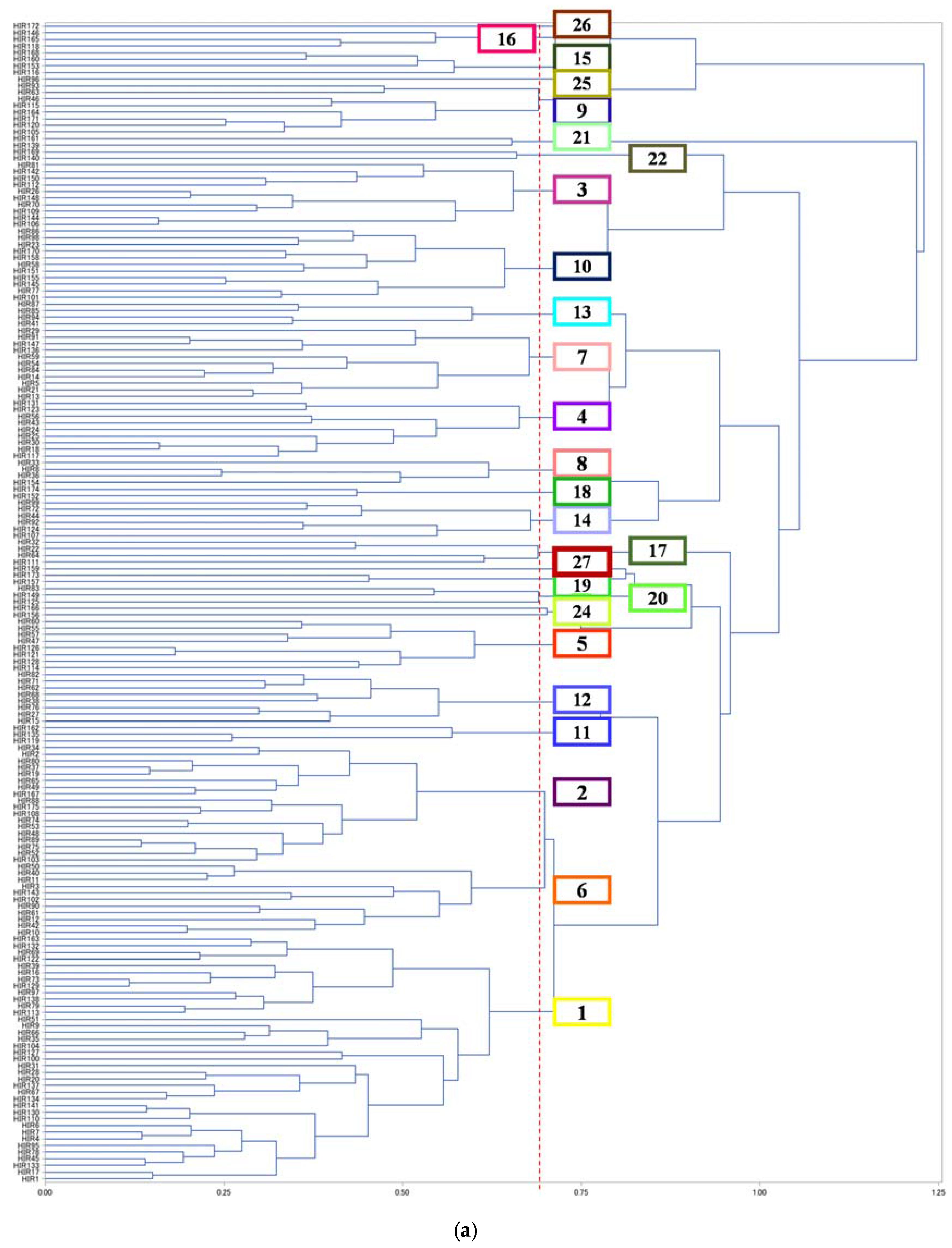
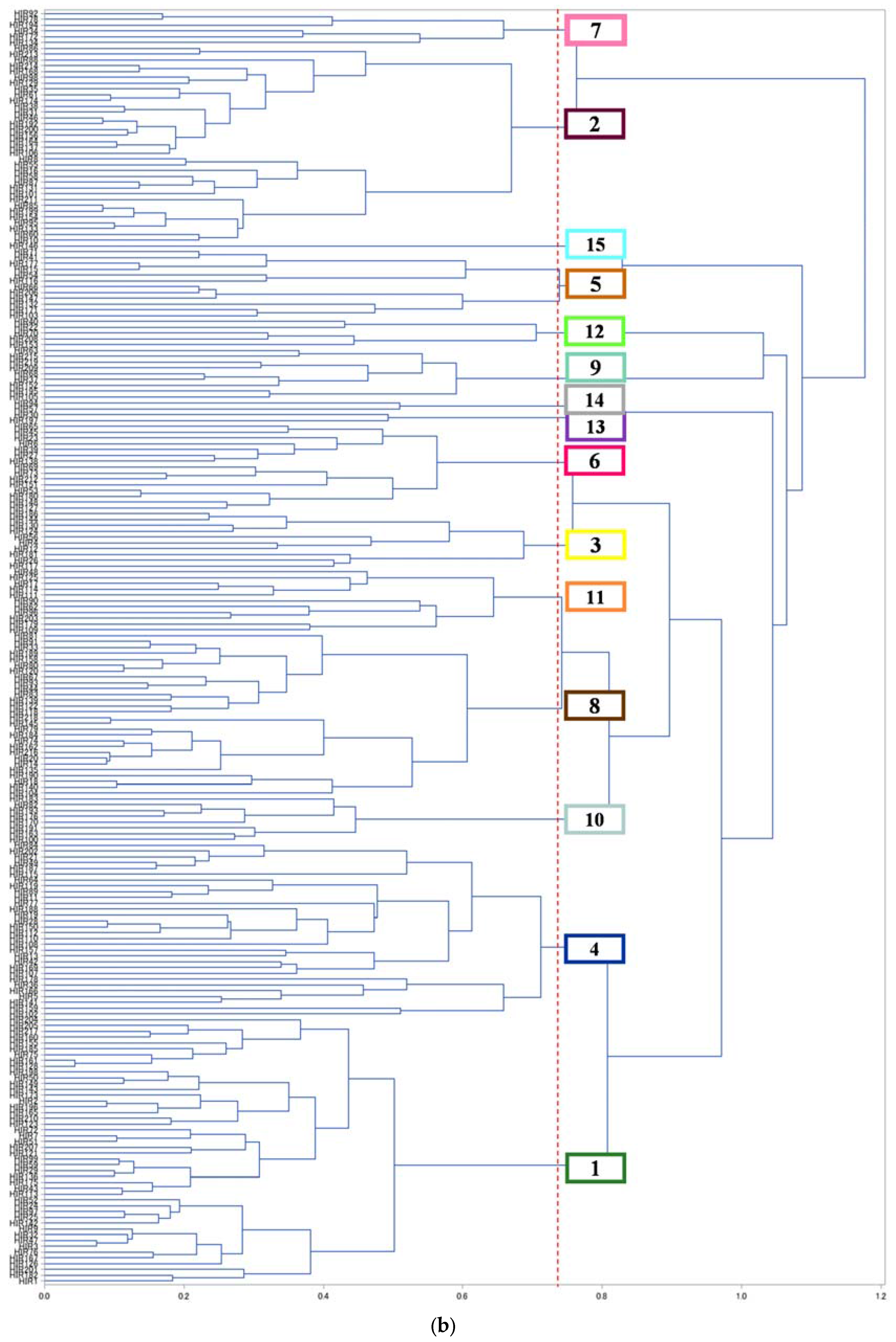
References
- McMillen, D.P.; McDonald, J.F. A nonparametric analysis of employment density in a polycentric city. J. Reg. Sci. 1997, 37, 591–612. [Google Scholar] [CrossRef]
- Jun, M.J.; Ha, S.K. Evolution of employment centers in Seoul. Rev. Urban Reg. Dev. Stud. 2002, 14, 117–132. [Google Scholar] [CrossRef]
- Baumont, C.; Ertur, C.; Gallo, J. Spatial analysis of employment and population density: the case of the agglomeration of Dijon 1999. Geogr. Anal. 2004, 36, 146–176. [Google Scholar] [CrossRef]
- Roth, C.; Kang, S.M.; Batty, M.; Barthélemy, M. Structure of urban movements: polycentric activity and entangled hierarchical flows. PLoS ONE 2011, 6, e15923. [Google Scholar] [CrossRef] [PubMed]
- Zhong, C.; Arisona, S.M.; Huang, X.; Batty, M.; Schmitt, G. Detecting the dynamics of urban structure through spatial network analysis. Int. J. Geogr. Inf. Sci. 2014, 28, 2178–2199. [Google Scholar] [CrossRef]
- Craig, S.G.; Kohlhase, J.E.; Perdue, A.W. Empirical polycentricity: The complex relationship between employment centers. J. Reg. Sci. 2016, 56, 25–52. [Google Scholar] [CrossRef]
- Yang, X.; Fang, Z.; Xu, Y.; Shaw, S.L.; Zhao, Z.; Yin, L.; Lin, Y. Understanding spatiotemporal patterns of human convergence and divergence using mobile phone location data. ISPRS Int. J. Geo-Inf. 2016. [Google Scholar] [CrossRef]
- Helsley, R.W.; Sullivan, A.M. Urban subcenter formation. Reg. Sci. Urban Econ. 1991, 21, 255–275. [Google Scholar] [CrossRef]
- Geohash. Geohash Tips & Tricks; 2017. Available online: http://Geohash.org/site/tips.html (accessed on 1 May 2017).
- Pelletier, M.P.; Trépanier, M.; Morency, C. Smart card data use in public transit: A literature review. Transp. Res. C Emer. Technol. 2011, 19, 557–568. [Google Scholar] [CrossRef]
- Morency, C.; Trépanier, M.; Agard, B. Analysing the Variability of Transit Users’ Behaviour with Smart Card Data. In Proceedings of the 19th International IEEE Intelligent Transportation Systems Conference (ITSC), Toronto, ON, Canada, 17–20 September 2006; pp. 44–49. [Google Scholar]
- Morency, C.; Trepanier, M.; Agard, B. Measuring transit use variability with smart-card data. Transp. Policy 2007, 14, 193–203. [Google Scholar] [CrossRef]
- Ma, X.; Wu, Y.J.; Wang, Y.; Chen, F.; Liu, J. Mining smart card data for transit riders’ travel patterns. Transp. Res. C Emer. Technol. 2013, 36, 1–12. [Google Scholar] [CrossRef]
- Kieu, L.M.; Bhaskar, A.; Chung, E. Passenger segmentation using smart card data. IEEE Trans. Intell. Transp. 2015, 16, 1537–1548. [Google Scholar] [CrossRef]
- Kim, K.; Oh, K.; Lee, Y.K.; Kim, S.; Jung, J.-Y. An analysis on movement patterns between zones using smart card data in subway networks. Int. J. Geogr. Inf. Sci. 2014, 28, 1781–1801. [Google Scholar] [CrossRef]
- Du, B.; Yang, Y.; Lv, W. Understand Group Travel Behaviors in an Urban Area Using Mobility Pattern Mining. In Proceedings of the 10th IEEE International Conference on Ubiquitous Intelligence and Computing and 10th International Conference on Autonomic and Trusted Computing (UIC/ATC), Washington, DC, USA, 3–6 December 2013; pp. 127–133. [Google Scholar]
- Tao, S.; Corcoran, J.; Mateo-Babiano, I.; Rohde, D. Exploring Bus Rapid Transit passenger travel behaviour using big data. App. Geogr. 2014, 53, 90–104. [Google Scholar] [CrossRef]
- Tao, S.; Rohde, D.; Corcoran, J. Examining the spatial–temporal dynamics of bus passenger travel behaviour using smart card data and the flow-comap. J. Transp. Geogr. 2014, 41, 21–36. [Google Scholar] [CrossRef]
- Long, Y.; Thill, J.C. Combining smart card data and household travel survey to analyze jobs–housing relationships in Beijing. Comp. Environ. Urban Syst. 2015, 53, 19–35. [Google Scholar] [CrossRef]
- Zeng, W.; Fu, C.W.; Arisona, S.M.; Schubiger, S.; Burkhard, R.; Ma, K.L. Visualizing the Relationship Between Human Mobility and Points of Interest. IEEE Trans. Intell. Transp. Syst. 2017, 18, 2271–2284. [Google Scholar] [CrossRef]
- Zhong, C.; Huang, X.; Arisona, S.M.; Schmitt, G.; Batty, M. Inferring building functions from a probabilistic model using public transportation data. Comput. Environ. Urban Syst. 2014, 48, 124–137. [Google Scholar] [CrossRef]
- Bagchi, M.; White, P.R. The potential of public transport smart card data. Transp. Policy 2005, 12, 464–474. [Google Scholar] [CrossRef]
- Kusakabe, T.; Asakura, Y. Behavioural data mining of transit smart card data: A data fusion approach. Transp. Res. C Emer Technol. 2014, 46, 179–191. [Google Scholar] [CrossRef]
- Cats, O.; Wang, Q.; Zhao, Y. Identification and classification of public transport activity centres in Stockholm using passenger flows data. J. Transp. Geogr. 2015, 48, 10–22. [Google Scholar] [CrossRef]
- Zhu, X.; Guo, D. Mapping large spatial flow data with hierarchical clustering. Trans. GIS 2014, 18, 421–435. [Google Scholar] [CrossRef]
- Song, Y.; Lee, K.; Anderson, W.P.; Lakshmanan, T.R. Industrial agglomeration and transport accessibility in metropolitan Seoul. J. Geogr. Syst. 2012, 14, 299–318. [Google Scholar] [CrossRef]
- Wu, W.; Xu, J.; Zeng, H.; Zheng, Y.; Qu, H.; Ni, B.; Ni, L.M. Telcovis: Visual exploration of co-occurrence in urban human mobility based on telco data. IEEE Trans. Vis. Comput. Graph. 2016, 22, 935–944. [Google Scholar] [CrossRef] [PubMed]
- Andrienko, G.; Andrienko, N.; Hurter, C.; Rinzivillo, S.; Wrobel, S. Scalable analysis of movement data for extracting and exploring significant places. IEEE Trans. Vis. Comput. Graph. 2013, 19, 1078–1094. [Google Scholar] [CrossRef] [PubMed]
- Bahamonde, J.; Hevia, A.; Font, G.; Bustos-Jimenez, J.; Montero, C. Mining private information from public data: The Transantiago Case. IEEE Pervas. Comp. 2014, 13, 37–43. [Google Scholar] [CrossRef]
- Ma, Y.; Xu, W.; Zhao, X.; Li, Y. Modeling the hourly distribution of population at a high spatiotemporal resolution using subway smart card data: A case study in the central area of Beijing. ISPRS Int. J. Geo-Inf. 2017, 6, 128. [Google Scholar] [CrossRef]
- Sanders, R. The Pareto principle: Its use and abuse. J. Serv. Mark. 1987, 1, 37–40. [Google Scholar] [CrossRef]
- Juran, J.M.; Gryna, F.M. Juran’s Quality Control Handbook, 5th ed.; McGraw-Hill: New York, NY, USA, 1998; ISBN 0-07-034003-X. [Google Scholar]
- Olson, C.F. Parallel algorithms for hierarchical clustering. Parallel Comput. 1995, 21, 1313–1325. [Google Scholar] [CrossRef]
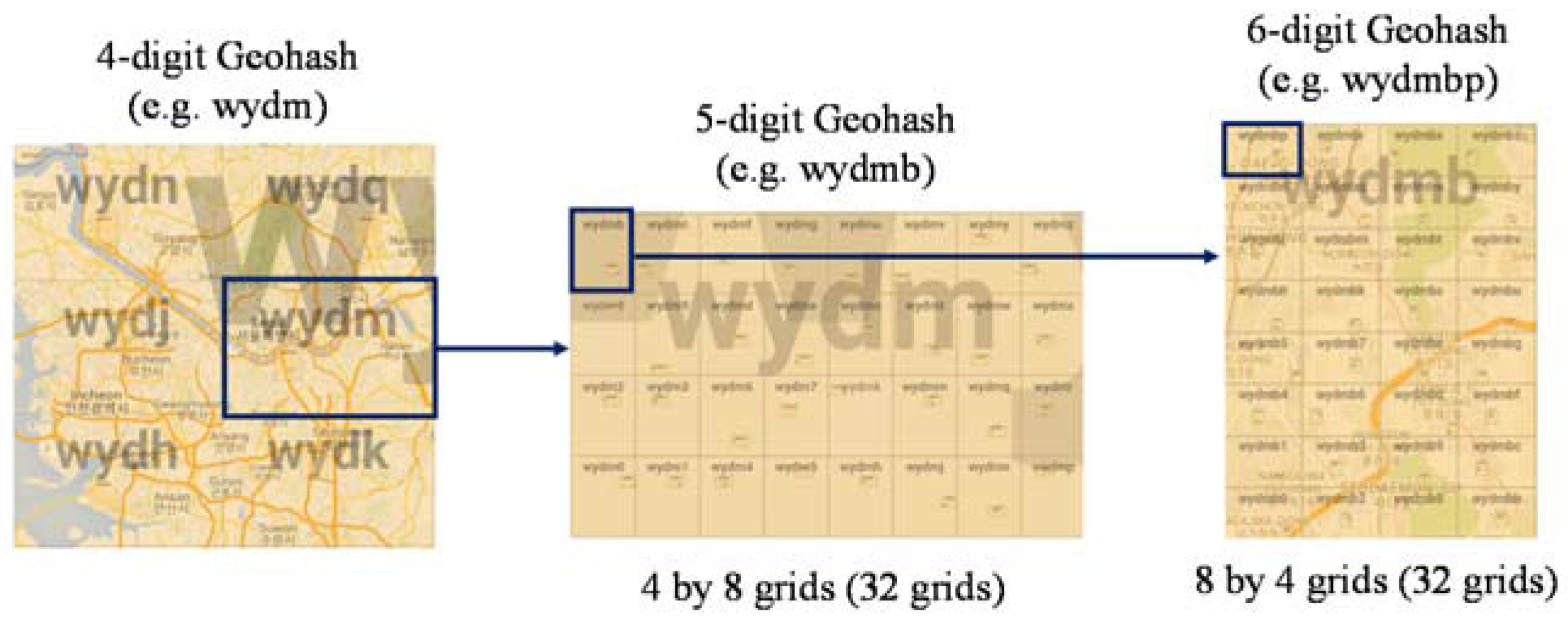
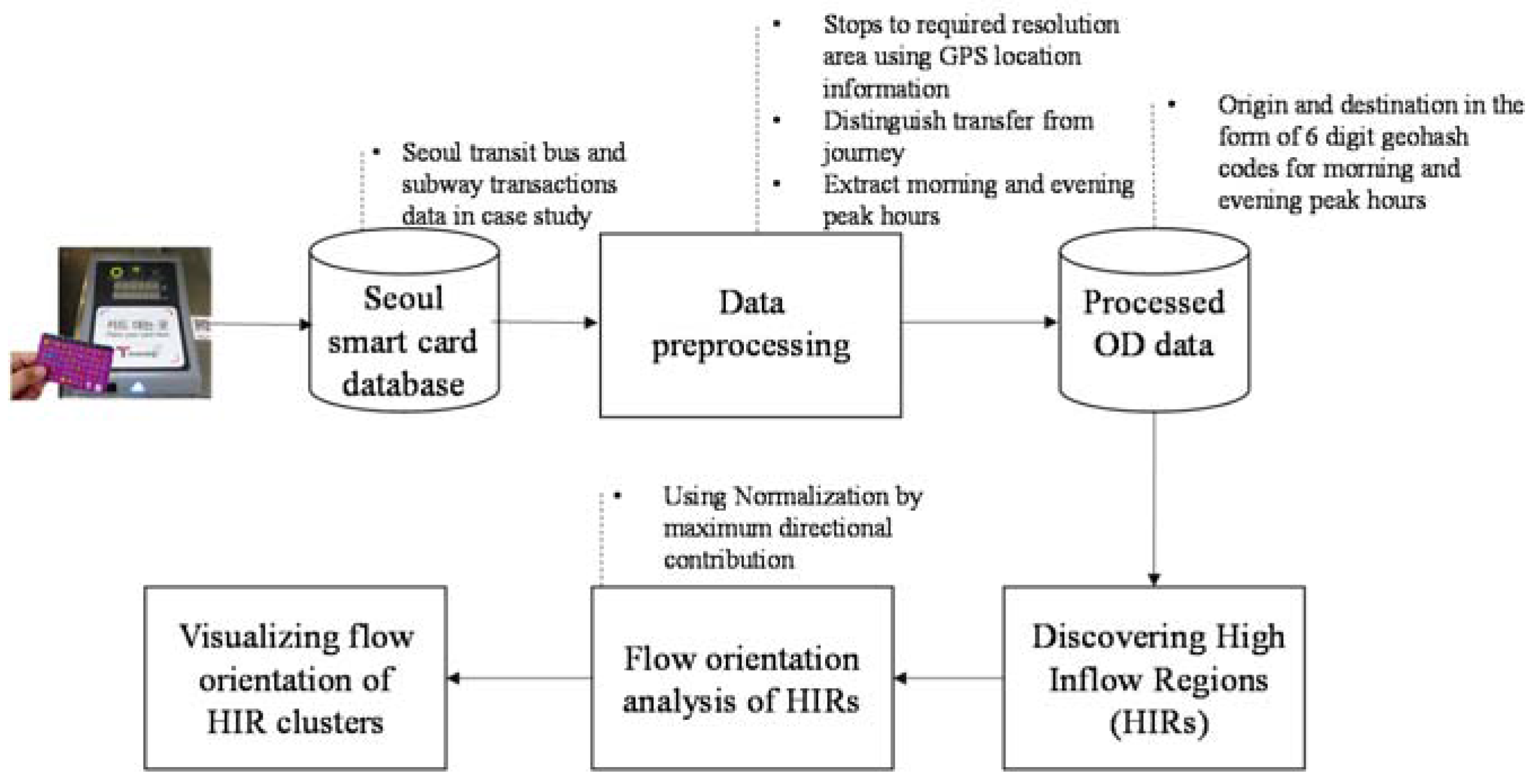

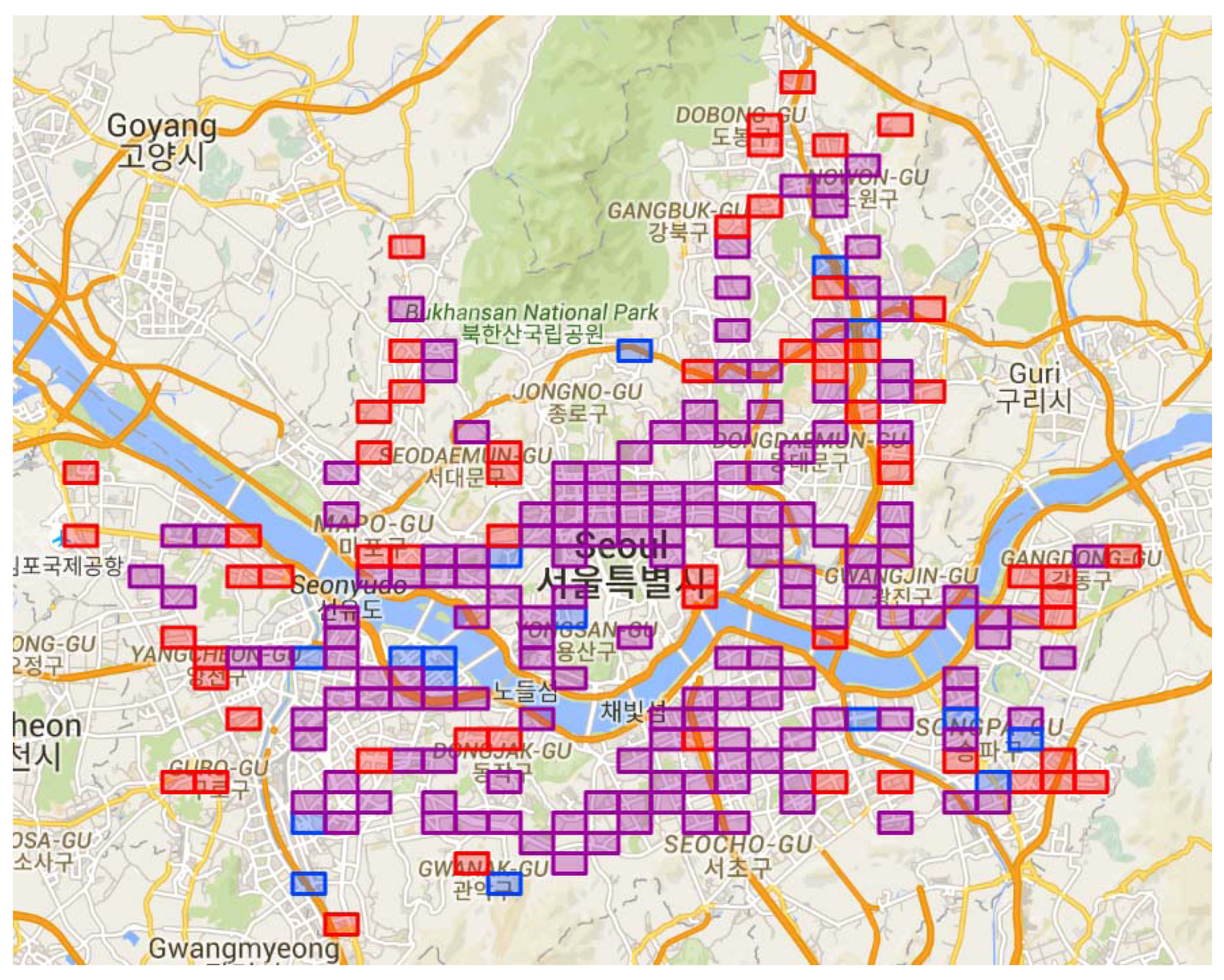

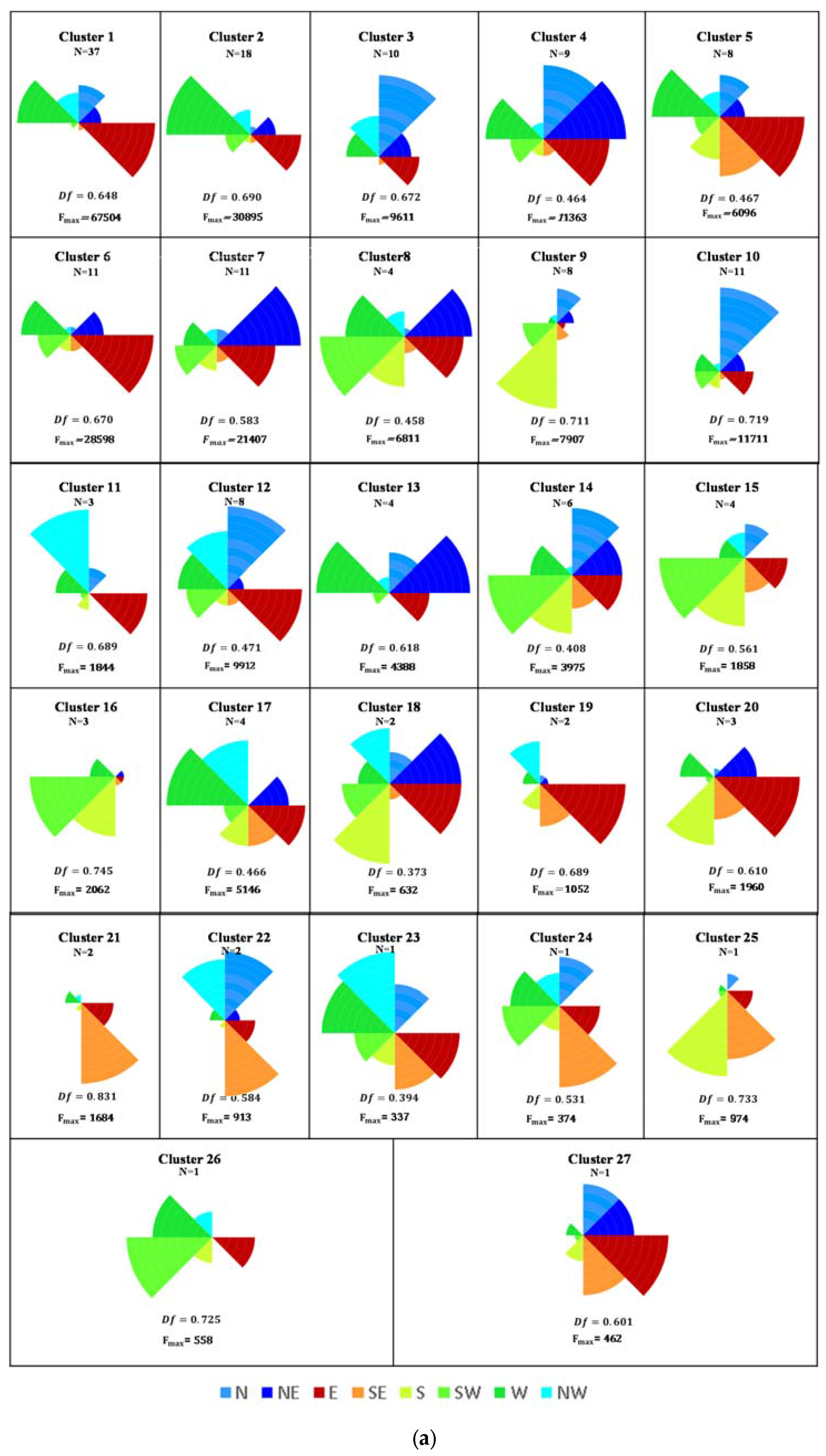
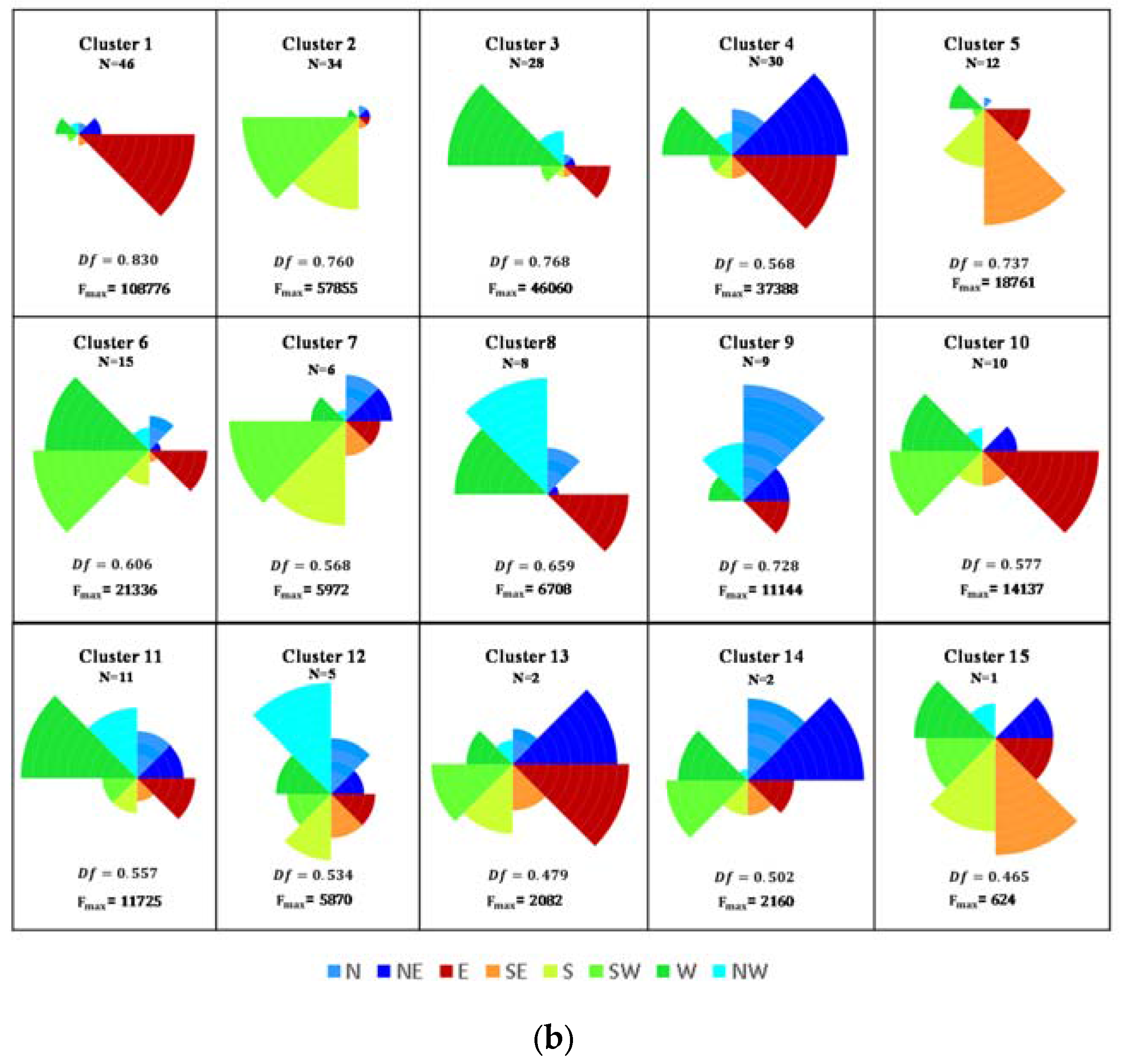
| Category | Subject | Method | Transit Data |
|---|---|---|---|
| Geographical clustering | Travelers for age occupation wise travel behavior [11] | k-means | 277 consecutive days |
| Travelers for regularity in boarding [12] | k-means | 277 consecutive days | |
| Mining travel patterns [13] | DBSCAN | 5 consecutive weekdays | |
| Origin-destination pairs for discovering zones based on movement patterns [15] | Clustering | 5 consecutive weekdays | |
| Travelers for direction and destination of travel [16] | DBSCAN | 92 days | |
| Subway stations for high inflow poly-center [4] | k-means | 1 week | |
| Travelers for temporal boarding pattern [14] | DBSCAN | 4 months | |
| Movement visualization | Drawing travel trajectory and visual representation of movement pattern [17,18] | co-map | 5 days |
| Job housing location and commuting pattern [19] | GIS platform | 7 days | |
| Interactive visualization of human mobility with activity context [20] | - | 1 week | |
| Relationship extraction | Relationship between mobility pattern of individual and daily activities [21] | Bayesian classifier | 1 week |
| Travel behavior analysis by measuring passenger turnover [22] | rule-based method | Approx. 3 years | |
| Behavioral trip purpose estimation [23] | Bayesian classifier | 20 months | |
| Relation of arrival and departure at certain station [20] | - | 1 week | |
| Flow orientation | Discovering flow orientation for poly-centers [5] | compass direction | 1 week |
| Discovering spark regions based on high density routes [16] | DBSCAN | 92 days | |
| Identifying activity centers and clustering them for spatial proximity and temporal flows [24] | clustering | 1 day | |
| Identifying industrial agglomerations and their orientation with respect to different modes of transport to check importance of transport accessibility [25] | - | 1 day |
| Attribute | Description | Data Type |
|---|---|---|
| Passenger code | Smart card serial number | Numeric |
| Origin station | Origin station number (card punch in) | Numeric |
| Boarding time | Boarding date and time at origin station | Date time |
| Destination station | Destination station number (card punch out) | Numeric |
| Alighting time | Alighting date and time at destination station | Date time |
© 2017 by the authors. Licensee MDPI, Basel, Switzerland. This article is an open access article distributed under the terms and conditions of the Creative Commons Attribution (CC BY) license (http://creativecommons.org/licenses/by/4.0/).
Share and Cite
Singh, P.; Oh, K.; Jung, J.-Y. Flow Orientation Analysis for Major Activity Regions Based on Smart Card Transit Data. ISPRS Int. J. Geo-Inf. 2017, 6, 318. https://doi.org/10.3390/ijgi6100318
Singh P, Oh K, Jung J-Y. Flow Orientation Analysis for Major Activity Regions Based on Smart Card Transit Data. ISPRS International Journal of Geo-Information. 2017; 6(10):318. https://doi.org/10.3390/ijgi6100318
Chicago/Turabian StyleSingh, Parul, Kyuhyup Oh, and Jae-Yoon Jung. 2017. "Flow Orientation Analysis for Major Activity Regions Based on Smart Card Transit Data" ISPRS International Journal of Geo-Information 6, no. 10: 318. https://doi.org/10.3390/ijgi6100318





